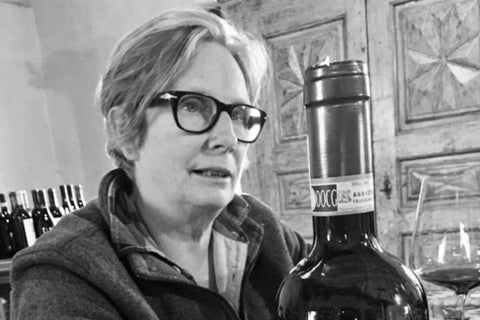The wine business – like many other fields – is one in which women have been underrepresented for too long. In recent years, however, women have taken a more prominent presence in the wine world: as producers, sommeliers, and wine writers. In this blog series, we will introduce you to some of the most interesting female natural winemakers.
Winemaker: Nicoletta Bocca of San Fereolo Winery
Nicoletta Bocca left Milan in 1992 for the Piedmontese countryside of Dogliani to become a winemaker. Her inspiration came from her father who since long had been a great wine lover and for years had been taking the family to the Langhe area of Piedmont, an area which during Nicoletta’s childhood appeared as a sort of paradise.
Coming from a traditional enological background, Nicoletta started making organic wines in 2004. She was influenced by her neighbor in Dogliani who, without being affiliated with any sort of movement, simply always had made wine without adding anything to it with minimum intervention in the vineyard.
In 2005 Nicoletta started using biodynamic practices in the vineyard as an attempt to improve the health of her vines. The biodynamic approach is still at the heart of the winemaking of this Dogliani producer. San Fereolo’s vineyards are spread out over the Dogliani area in the southwest of Piedmont - together representing an area of 12 hectares, and in all producing around 45.000 bottles a year.
San Fereolo focuses on the Piedmontese autochthonous varieties Dolcetto, Barbera, and Nebbiolo but also grows the varieties Riesling and Gewurtztraminer.
The Vineyard is the Cradle
The wines of San Fereolo are a clear reflection of the philosophy and spirit of the winemaker. Nicoletta’s path to becoming a winemaker has been defined by an ambition to be true to herself, to give depth and meaning and to put her own character in her wines. Some main qualities which she focuses on in her production are age worthiness, evolution, consistency, and elegance.
Nicoletta takes a clear standpoint against the competitiveness and judgment in the wine world, what she describes an obsession of lists such as: who are the ten best female winemakers in the world? which are the ten best wines in the world? - an approach which always departs from an external point of view. It is, as she says, an "almost pornographic gaze, it's not love".
Love and dedication, on the other hand, are definitely the main ingredients in the working methods of San Fereolo. And everything starts in the vineyard, where dedication and attention but also a great humbleness must be applied. For Nicoletta it is just as much about listening to and observing nature as guiding it.
Since every intervention in the vineyard brings a consequence, the winegrower must be careful and caring and understand that we depend on nature. If we don´t listen to nature we do not get the result we wish, so finding this balance is fundamental.
Reality as a Process
It might take some effort to understand what biodynamics is about, but, says Nicoletta, it is worth it. The biodynamic approach allows for the possibility to go beyond the single physical details of winemaking and to achieve a more holistic perspective. It offers a sensibility and foresight which is not common in other agricultural methods.
Biodynamics has a conception of reality as a set of processes. Within this view, the winemaker is, rather than a manipulator, a mediator who observes and reacts to the processes already occurring in nature. By assisting nature in its own evolution, the inherent potential of the grape is allowed to be expressed. Nicoletta describes the natural wine world as having been essential as a reaction to a too technical idea of winemaking that has dominated for long.
The natural wine world in this way has challenged and called into question old norms, which is positive. Probably, says Nicoletta, just like what happens to many people during teenage years when trying out new ideas, sooner or later we will turn back to our roots, but with a new outlook on things. In the same way, biodynamics works as a way of amplifying the vision of the world. This does not mean denying what we know but rather integrating and going beyond it.
Dogliani, Land of Dolcetto
The winemaking area Dogliani DOCG in the south of Piedmont is known for being an excellent area for growing the Dolcetto grape. Already in 1593 the first written documentation attesting the ancient roots of the grape in this territory has been found. When starting to produce wine, Nicoletta immediately wanted to valorize Dolcetto, a variety whose potential perhaps has been underrated historically.
Dolcetto wines are generally considered simple table wines not adapted for aging. San Fereolo works with changing this perception through the exploration of the aging potential and character of this tannic variety, for instance through fermentation and aging in wooden barrels. In a time where many winemakers focus on the prestige of various “crus”, Nicoletta's focus is different; she is on a journey to discover the evolution of Dolcetto through time and wants to communicate the qualities of different vintages.
The work of San Fereolo implies great attention to the grapes in the vineyards as well as in the cellar, applying the principles of biodynamic agriculture to enhance the soil fertility and the use of copper and sulfur in very small quantities. According to Nicoletta the biodynamic approach helps to give the Dolcetto grapes a more interesting character and higher vitality.
Today, when many producers in Piedmont are converting their vineyards to Nebbiolo grapes to focus on the more prestigious and economically lucrative wines, the effort of San Fereolo is admirable and important. The great strength of Piedmont as a wine region is its big variety giving birth to many different wines, a diversity which hopefully can be kept alive through the hard work of producers such as San Fereolo.
Author: Sara Nässén ©










